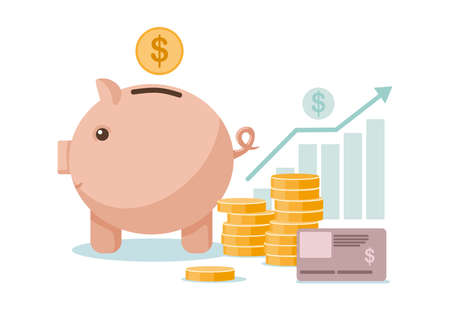1. Understanding Tax-Advantaged Accounts
When you’re dreaming of buying your first home, figuring out how to save for that down payment can feel overwhelming. That’s where tax-advantaged accounts come in. These special types of financial accounts are designed to help you save money while offering unique tax benefits, making your path to homeownership a little bit smoother.
What Are Tax-Advantaged Accounts?
Tax-advantaged accounts are savings or investment vehicles that offer specific tax benefits—either tax deferral, tax-free growth, or tax deductions. The U.S. government created these accounts to encourage people to save for important goals like retirement, education, and even medical expenses. While not all tax-advantaged accounts are intended specifically for home purchases, some can be creatively used as part of your down payment strategy.
Main Types of Tax-Advantaged Accounts in the U.S.
| Account Type | Main Purpose | Tax Benefit | Possible Use for Down Payment |
|---|---|---|---|
| 401(k) & Traditional IRA | Retirement Savings | Tax-deferred growth; contributions may be pre-tax | Some exceptions allow penalty-free withdrawal for first-time homebuyers |
| Roth IRA | Retirement Savings | Tax-free growth; qualified withdrawals are tax-free | Contributions (and up to $10,000 of earnings) can be withdrawn for first-time home purchase without penalty |
| Health Savings Account (HSA) | Medical Expenses | Triple tax advantage: pre-tax contributions, tax-free growth, and tax-free withdrawals for qualified expenses | Not typically used for housing but can free up other savings by covering medical costs tax-free |
| 529 College Savings Plan | Education Expenses | Tax-free growth and withdrawals when used for qualified education expenses | Not designed for housing but sometimes used creatively if education costs overlap with housing needs (e.g., student housing) |
The Benefits: Why Consider Tax-Advantaged Accounts?
The biggest perk of these accounts is the ability to grow your money faster by minimizing the taxes you owe along the way. For example, Roth IRAs let you withdraw contributions at any time and even use up to $10,000 of earnings toward a first-time home purchase—tax and penalty free if certain conditions are met. This makes them especially helpful if you want to balance retirement planning with saving for a home.
Quick Look: Tax Advantages That Help Your Savings Grow Faster
- Tax-deferred: Pay taxes later, so more of your money stays invested now.
- Tax-free: Some withdrawals (like from Roth IRAs) aren’t taxed at all if you follow the rules.
- Deductions: Certain contributions lower your taxable income today, giving you an immediate break.
The Bottom Line on Tax-Advantaged Accounts for Home Savings
If you’re planning ahead for a house down payment, understanding how these accounts work—and how they fit into your overall savings plan—can give you a powerful boost. In the next sections, we’ll dive deeper into strategies for using these accounts to maximize your savings potential on the road to homeownership.
2. Types of Tax-Advantaged Accounts for Savers
Understanding the Options: Roth IRAs, Traditional IRAs, and 401(k)s
When it comes to saving for a house down payment, many Americans first think of regular savings accounts. However, tax-advantaged accounts can play a powerful role in helping you reach your goal faster. Let’s break down three popular options—Roth IRA, Traditional IRA, and 401(k)—and see how each one can fit into your home-buying journey.
How These Accounts Work for Home Savings
Each of these accounts offers unique features and tax benefits that can help your savings grow more efficiently. Here’s a quick comparison:
| Account Type | Main Tax Benefit | Home Purchase Perk | Withdrawal Rules (For First-Time Homebuyers) |
|---|---|---|---|
| Roth IRA | Tax-free growth & withdrawals (if qualified) | Can withdraw up to $10,000 of earnings for first-time home purchase penalty-free | Must have account open for at least 5 years; contributions can be withdrawn anytime |
| Traditional IRA | Tax-deductible contributions, tax-deferred growth | Can withdraw up to $10,000 penalty-free for first-time home purchase (still pay income tax) | Penalty waived for qualified home purchase; regular taxes apply on withdrawals |
| 401(k) | Tax-deferred growth; possible employer match | May allow loans or hardship withdrawals for buying a primary residence | Loan must be repaid with interest; hardship withdrawal may incur taxes & penalties if not qualified |
The Roth IRA Advantage for Aspiring Homeowners
The Roth IRA is especially popular among young savers. Not only do you get to withdraw your contributions at any time without taxes or penalties, but you can also use up to $10,000 of investment gains toward your first home if the account has been open five years. That flexibility makes it a go-to option for many first-time buyers.
Traditional IRA: An Extra Boost with Some Limits
If you qualify for deductible contributions, a Traditional IRA lets you put away pre-tax money and enjoy tax-deferred growth. Like the Roth IRA, you can tap into up to $10,000 for a first home without the usual early withdrawal penalty—but keep in mind you’ll still owe regular income tax on what you take out.
Using Your 401(k) to Jumpstart Your Down Payment
A 401(k) might seem off-limits until retirement, but some plans let you borrow from your balance or make hardship withdrawals to buy a house. Loans must be paid back (usually within five years), and taking money out could impact your long-term retirement savings—so weigh this option carefully before making a move.
Quick Tips:
- If you’re planning to buy your first home in the next few years, start by checking if you’re eligible to contribute to an IRA or participate in your employer’s 401(k) plan.
- Consider the Roth IRA if you want maximum flexibility and expect to be in a higher tax bracket later.
- Always consult with a financial advisor before making large withdrawals from retirement accounts—your future self will thank you!

3. How Tax-Advantaged Accounts Can Be Used for a Home Down Payment
Understanding the Basics of Tax-Advantaged Accounts
When you’re dreaming about buying your first home, saving for that big down payment can feel overwhelming. That’s where tax-advantaged accounts come in—they’re designed to help you grow your savings faster by letting your money work for you with some sweet tax perks. Let’s break down how these accounts can actually help you get closer to owning your own place.
Major Tax-Advantaged Accounts and Home Buying
The main types of tax-advantaged accounts people use for home down payments in the U.S. are:
- Traditional IRAs
- Roth IRAs
- 401(k) Plans
Each account has its own rules, especially when it comes to pulling out money for a house. Here’s a quick look at how they stack up:
| Account Type | Qualified First-Time Homebuyer Benefit | IRS Allowance (2024) | Restrictions & Penalties |
|---|---|---|---|
| Traditional IRA | Up to $10,000 can be withdrawn penalty-free for a first-time home purchase | $10,000 lifetime limit per individual | Still pay regular income tax on withdrawal amount; penalty-free only if used for qualified expenses |
| Roth IRA | Contributions can always be withdrawn tax- and penalty-free; up to $10,000 of earnings can also be withdrawn tax- and penalty-free if account is 5+ years old and used for a first-time home purchase | $10,000 lifetime limit on earnings portion per individual | If under 5 years, earnings may face taxes and penalties; contributions remain accessible anytime |
| 401(k) | You can take a loan (usually up to 50% of vested balance, max $50,000) or hardship withdrawal for down payment needs | Loan: Up to $50,000 or 50% of vested balance Hardship: Amount necessary for purchase |
Loans must be repaid with interest; hardship withdrawals incur income tax and possibly 10% penalty if under age 59½ unless exception applies |
The IRS Definition of “First-Time Homebuyer”
The IRS defines a “first-time homebuyer” as someone who hasn’t owned a principal residence in the last two years. This rule is more flexible than most people think—so even if you owned a house in the past but sold it over two years ago, you could still qualify!
Key Rules and Opportunities You Should Know About
- You don’t have to buy alone: The $10,000 IRA limit applies per person. If you’re buying with a spouse, that means you could access $20,000 together from your IRAs.
- No need for huge withdrawals: For Roth IRAs, you can always take out what you put in—no taxes or penalties—no matter what. Earnings have their own rules though.
- The five-year rule matters: With Roth IRAs, make sure your account is at least five years old before tapping into earnings for a home down payment. Otherwise, you might owe taxes or penalties.
- 401(k) loans are not free money: You’ll have to pay yourself back—with interest—and leaving your job could mean paying it all back right away.
- Your state might offer more: Some states have their own first-time homebuyer savings programs with special tax breaks. It’s worth checking out local options!
A Real-Life Example: The Johnsons’ Journey Home
The Johnsons had been renting in Dallas for years when they decided it was time to buy their own place. Both had Roth IRAs they’d contributed to for over five years. By each taking out $10,000 in earnings (plus any contributions), they were able to put $25,000 toward their dream home—without paying extra taxes or penalties. Their secret? Knowing the IRS rules and planning ahead.
Your Next Step: Explore Your Accounts’ Potential
If buying your first home is on your radar, check out which tax-advantaged accounts you already have—and how their rules line up with your goals. Sometimes, just understanding these opportunities makes all the difference between renting and finally having a place to call your own.
4. The Pros and Cons of Using Retirement Accounts for Home Purchases
The Temptation: Tapping Your Nest Egg for a House
For many Americans, the dream of homeownership feels just out of reach. When you see your 401(k) or IRA balance growing, it’s easy to wonder if you should use those savings to help with a house down payment. Tax-advantaged accounts like 401(k)s and IRAs offer ways to access funds, but using retirement money for a home purchase comes with both upsides and downsides. Let’s break down what you need to know before making this big move.
Advantages of Using Retirement Accounts for a Down Payment
| Advantage | Details |
|---|---|
| Access to Large Sums | If you’ve been saving for years, your 401(k) or IRA might hold enough for a significant down payment—potentially helping you avoid private mortgage insurance (PMI). |
| Potential Penalty-Free Withdrawals | First-time homebuyers can withdraw up to $10,000 from an IRA without paying the usual 10% early withdrawal penalty (though regular income taxes may still apply). |
| Loan Options | Some 401(k) plans let you borrow against your balance (usually up to $50,000 or 50% of your vested amount), which means you’re paying yourself back with interest instead of losing that money forever. |
| No Credit Check Needed | Borrowing from your retirement account doesn’t require lender approval or affect your credit score. |
Drawbacks to Consider Before Withdrawing Retirement Funds
| Drawback | Details |
|---|---|
| Taxes and Penalties | Unless you qualify for specific exceptions, early withdrawals from retirement accounts may trigger a 10% penalty plus regular income tax. Even penalty-free withdrawals are taxed as ordinary income. |
| Losing Out on Compound Growth | The money you pull out stops working for your future. You’ll lose years of potential investment growth—this could mean tens of thousands less at retirement. |
| Repayment Risks (Loans Only) | If you borrow from your 401(k) and leave your job (voluntarily or not), the loan often becomes due immediately. If you can’t pay it back, it’s treated as a withdrawal—with taxes and penalties. |
| Lower Retirement Security | Dipping into your nest egg now may put your long-term financial goals at risk, especially if you don’t have other sources of retirement savings. |
Quick Comparison: IRA vs. 401(k) for Home Purchase
| IRA | 401(k) | |
|---|---|---|
| Penalty-Free Withdrawal Limit for First-Time Buyers | $10,000 lifetime limit (must meet first-time buyer rule) | N/A (early withdrawals usually penalized) |
| Loan Option? | No loans allowed from IRAs | Loans allowed in many plans (up to $50,000 or 50%) |
| Tax Implications | Pays income tax on withdrawal; penalty waived if qualified first-time homebuyer | Pays back loan with interest; taxes/penalties only if not repaid on time or upon leaving job |
| Affects Credit Score? | No impact | No impact unless defaulted loan is treated as distribution |
Think Long-Term Before You Tap In!
Tapping into retirement accounts for a down payment can help open the door to homeownership sooner—but it comes at a cost. Be sure to weigh both the immediate benefits and long-term consequences before making a decision. If possible, talk with a financial advisor who understands both real estate and retirement planning so you can create the best path toward both owning a home and securing your future.
5. Strategic Savings Tips for Would-Be Homeowners
Make the Most of Tax-Advantaged Accounts
Saving for a house down payment can feel overwhelming, but smart use of tax-advantaged accounts can make a huge difference. If you’re dreaming about homeownership, these accounts—like Roth IRAs, HSAs (in some cases), and 401(k)s—can help your savings grow faster by reducing your tax bill. Here’s how you can strategically use them:
1. Tap Into Your Roth IRA
If you’ve had a Roth IRA for at least five years, you can withdraw up to $10,000 in earnings tax-free for a first-time home purchase. Contributions (the money you put in) can be taken out anytime, so it’s a flexible option for saving toward your down payment.
| Account Type | Home Down Payment Benefit |
|---|---|
| Roth IRA | Withdraw up to $10,000 earnings plus contributions penalty-free for first-time home purchase |
| Traditional IRA | Withdraw up to $10,000 penalty-free (but pay income taxes on the amount) |
| 401(k) | Borrow from your account or take hardship withdrawal (check plan details and potential penalties/taxes) |
2. Set Up Automatic Transfers
The key to consistent savings is automation. Set up direct deposits from your paycheck into your tax-advantaged account so you’re not tempted to spend what you could be saving. Even $50 or $100 every payday adds up over time.
3. Track Your Progress with Milestones
Break your savings goal into smaller milestones—maybe every $5,000 saved is a mini-celebration! This keeps you motivated and helps you see the progress you’re making.
Real-Life Success Story: Meet Rachel and Chris
Rachel and Chris wanted to buy their first home in Denver. They opened a Roth IRA at age 27 and contributed $200 monthly. After five years, they used $10,000 of their earnings plus all their contributions for their down payment—tax-free! Their disciplined approach and use of tax-advantaged accounts helped them achieve homeownership faster than friends who kept everything in regular savings.
4. Combine Multiple Accounts for Bigger Impact
If both you and your partner have IRAs or employer retirement plans, coordinate your strategies. For example, one person uses their Roth IRA withdrawal while the other takes a 401(k) loan—doubling your purchasing power without draining just one source.
5. Avoid Common Pitfalls
- Avoid withdrawing too much from retirement accounts—you don’t want to hurt your long-term savings goals.
- Always check eligibility rules and potential penalties before making withdrawals.
- Consult with a financial advisor if you’re unsure about the best way to use these accounts for your situation.
Your Next Steps
Start by opening the right accounts if you haven’t already, set realistic targets, automate your contributions, and celebrate each milestone. With the right strategy and discipline, tax-advantaged accounts can be your secret weapon on the road to buying your dream home!
6. Key Takeaways and Next Steps
When youre saving for a house down payment, tax-advantaged accounts can be powerful tools. Lets break down what weve learned so far and look at some practical steps you can take to decide if these accounts fit your homeownership journey.
Main Points Recap
| Account Type | Main Benefit | Things to Consider |
|---|---|---|
| Roth IRA | Tax-free withdrawals of contributions anytime, and up to $10,000 of earnings for first-time homebuyers without penalty | Annual contribution limits; potential impact on retirement savings |
| 401(k) Loan | Borrow against your retirement savings with no taxes or penalties if repaid on time | Must repay with interest; risk to retirement growth if not managed wisely |
| Health Savings Account (HSA) | Triple tax benefits: tax-deductible contributions, tax-free growth, tax-free withdrawals for qualified expenses | Withdrawals for non-medical expenses before age 65 are taxed and penalized |
| 529 Plan (for education but sometimes flexible) | Tax-free growth and withdrawals for qualified education expenses; some states allow use for first-time home purchase up to $10,000 lifetime maximum | State-by-state differences in rules; primary purpose is education savings |
Is a Tax-Advantaged Account Right for Your Down Payment?
- Your timeline: If you plan to buy a home within five years, check early withdrawal rules so you don’t get hit with penalties.
- Your current savings: Do you already have funds in these accounts, or are you just starting out? Think about how much you need and what’s realistic for your budget.
- Your comfort with risk: Some accounts invest in the market, which means value can go up or down. Make sure you’re comfortable with this as your house goal approaches.
- Your long-term plans: Are you sacrificing retirement or other important goals by tapping these funds? Try to find a balance that feels right.
Simple Next Steps You Can Take Today
- Review your existing accounts: Look at your Roth IRA, 401(k), HSA, and any other accounts to see what’s available.
- Talk to a financial advisor: A pro can help map out which options make sense for your unique situation.
- Create a down payment plan: Set a target amount and deadline. Use online calculators to estimate how much you need to save each month.
- Stay informed: Tax laws change! Check the latest IRS guidelines or state rules before making any big moves.
Your Homebuying Journey Starts Now!
The best savings plan is one that fits your lifestyle, goals, and timeline. Tax-advantaged accounts could give you an extra boost—but only if they line up with your personal roadmap. Take it step by step, ask lots of questions, and remember: every dollar saved gets you closer to opening the door of your new home!


